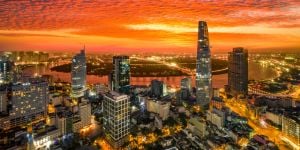
Vietnam is a country of striking contrasts, where ancient traditions meet rapid modernization. Stretching along Southeast Asia's eastern coast, it offers a vibrant mix of landscapes, cultures, and histories—from the misty mountains of the north to the bustling energy of the south. Shaped by centuries of change, Vietnam embraces its past while looking firmly to the future. Warm, welcoming, and resilient, its people and places offer a deep, authentic experience for those willing to explore beyond the surface. This guide will take you through the regions, culture, and everyday life that make Vietnam truly unforgettable.
Geography of Vietnam
The Socialist Republic of Vietnam, most commonly known as Vietnam, is a Southeast Asian country stretching 331,041 km². It is bordered by Laos, Cambodia, Thailand, and China, and the capital city is Hanoi or Hà Nội.
Demography of Vietnam
As of 2024, Vietnam's population is approximately 101.4 million. The official language is Vietnamese; however, some fifty other languages are spoken by different groups across the country, including Mandarin, Khmer, English, and French.
Vietnam is divided into three major regions: northern, central, and southern. Each contains a diverse and vibrant history, specific tonal dialect, and culinary highlights.
The northern region contains the capital city, Ho Chi Minh's mausoleum, and one of the natural wonders and UNESCO World Heritage Sites, Ha Long Bay. Life is slower and contains a more traditional outlook. The north goes through more seasonal weather and even gets colder winter temperatures, unlike the rest of the country. Culinary highlights focus more on noodles or “bún” and we encourage you to try bún thang (noodle soup with various toppings like shredded chicken, thinly sliced omelet, Vietnamese ham or "chả lụa", and dried shrimp) and bun dau mam tom (similar to a Vietnamese charcuterie plate in the presentation you'll find rice vermicelli, fried tofu, and fermented shrimp paste among other tasty treats).
The central region is where you'll find the sun chasers and beach dwellers. While this area is also home to the photogenic Hai Van Pass motorway, the historical citadel, and the Imperial City of Hue, you can also get tailor-made clothing done in twenty-four hours in the UNESCO World Heritage Site Hoi An ancient town. It's no surprise that life moves at a slower pace, and the culinary delights of this region focus on fresh seafood. Make sure to eat cao lầu (a noodle soup with various toppings but especially crunchy pork crackling) and bun bo Hue (a spicy, salty beef and pork broth) for the full experience.
The southern region is known for the hustle and bustle of Ho Chi Minh City, or Saigon, and the Mekong Delta. Life is energetic, and sugar is added to almost every drink and recipe. You'll find an eclectic balance of cuisines and collaboration with Vietnamese fusion, with Vietnamese who didn't grow up locally returning and quickly becoming immersed in the country and its genetic tapestry. Make sure to spend an overnight in the Mekong Delta and experience a river market where you'll be served breakfast on a traditional Vietnamese fishing boat, or spend the day in nature at Cat Tien National Park. Cơm Tấm, or broken rice, is a popular meal with street vendors grilling juicy tender pork served with shredded pork skin, steamed egg meatloaf, and sweet fish sauce with chili flakes floating on top.
History of Vietnam
Vietnam has a long and tumultuous history that is not ignored, but is also not in the driver's seat for future decisions or opinions on tourists. The Vietnamese have a beautiful way of honoring traditions from the past while looking ahead and refusing to hold any animosity for the past. Major historical events include the first unification of Vietnam by defeating Chinese forces in 938 CE, becoming a French colony in the mid-19th century until 1954, coinciding with the beginning of the Vietnam War.
In 1954, the French were defeated when they surrendered at the Battle of Dien Bien Phu. This triggered unrest across the country, and the battle for power between the North and South lasted from 1955 to 1975. The North was led by communist Ho Chi Minh and Prime Minister Ngo Dinh Diem. As other countries became involved to back the south, the lines of fighting for country independence became blurry, but the north prevailed, and unification was reached in 1975. Hanoi and Ho Chi Minh City have museums dedicated to the war and the horrific impact of Agent Orange, which can still be seen today.
Economy of Vietnam
Vietnam prides itself on being patriotic and looking ahead. Regardless of the past, this country is making up for lost time and, as of 2023, ranked 35th in the world. It takes fifth place for Southeast Asian markets behind Indonesia, Thailand, Singapore, and the Philippines. Vietnam's economy is based predominantly on agriculture, especially rice cultivation. The economy also benefits from exports, tourism, petroleum products, and mineral resources. The country's main export partners are China, Japan, and the United States. Vietnam is choosing to invest in green city planning to develop and keep up with its nearby competitors.
Politics in Vietnam
The Socialist Republic of Vietnam is an authoritarian state ruled by a single party, the Communist Party of Vietnam, led by General Secretary of the Communist Party of Vietnam (CPV) Tô Lâm, President Lương Cường, and the Prime Minister of Vietnam Phạm Minh Chính. It is viewed as impolite to discuss politics when you travel to Vietnam, and let your tour guide or colleagues set the pace of conversation if they wish to discuss.
Religion in Vietnam
Vietnam officially declares itself an atheist state. Considering the country's history and being influenced by its neighbouring lands, Vietnamese beliefs and practices are informed by three primary religions, namely Buddhism, Taoism, and Confucianism. This trinity is often referred to as the Triple Religion or Tam Giáo.
There is freedom of religion across the country and Christianity, Hinduism, and Islam are also practiced.
Culture in Vietnam
The Vietnamese population is extremely welcoming and kind. They are non-judgmental of other cultures and have many traditions that are passed down through generations. Pulling from diverse ethnic influences, pillars of the culture focus on strong family values, a deep respect for education, and appreciating and creating art.
You will find an altar in almost every structure in the country to connect the building, family, or workplace with their ancestors. Confucian principles, which emphasize filial piety, respect for authority, and social harmony, continue to play a significant role in shaping Vietnamese values.
Festivals and celebrations in Vietnam
Vietnam is home to numerous festivals and celebrations that everyone is welcome to participate in! It's very common to be invited to weddings and to join in community celebrations in local neighborhoods or alleyways. If you are planning an upcoming trip, keep an eye on when these dates fall on the calendar as they will impact opening hours and also have different displays across the country.
Tet (Lunar New Year)
Tet is the most significant festival in Vietnam, marking the beginning of the lunar calendar. The lunar new year follows a zodiac animal classification, with each one representing different strengths and expectations for the upcoming year. When Tet approaches, you'll see many floral displays set up around the city, including walking streets in Ha Noi, Da Nang, and Ho Chi Minh City that will pay homage to the new lunar animal through floats and large structures. Each region has a unique twist on the delicious banh chung/banh tet (sticky rice cakes), only for sale on Lunar New Year. Be aware that the first day of the new year is reserved for family, and many people will close businesses to travel back to their families' hometowns to celebrate for up to a week.
Mid-Autumn Festival or Tết Trung Thu
This festival focuses on families and the ancient legend of a carp being bested by his shadow. The story goes that there was once a carp spirit who would prowl at night and make it unsafe for people to be outside after dark. The spirit was bested by a farmer designing a carp-shaped lantern that showed a stick piercing the belly. All of the lantern shadows frightened the spirit on the evening when the moon was at its brightest, and it fled the village never to bother anyone again. Currently, the festival will be held on the day of the full moon (the 15th day) of the 8th lunar month, normally September or October. Decorations include lanterns of many different shapes and colors, and you'll see many mooncakes ranging from sweet to savory being handed out or given as festive gifts.
Christmas and the Gregorian Calendar New Year's Eve
If you find yourself abroad for Christmas and New Year's Eve, don't worry, you'll have many traditional activities available to remind you of home. Over the last five years, Vietnam has increased its winter festive spirit with Christmas markets, festive meals scheduled at high-end hotels or catered meals prepared for delivery, and a big fireworks celebration for December 31st. If you are traveling at this time, don't forget to pack a variety of clothing as the north will be cold and even potentially have snow, the central region will be in the rainy season, and the south will be at the beginning of its dry season!
Safety in Vietnam
In general, Vietnam is viewed as a safe country with very hospitable and welcoming hosts. However, you should always remain aware and alert while traveling and focus on a couple of key points:
- Download the Grab app for moving through cities. If you book a taxi, use services like VinaTaxi and make sure the meter is running or that the price is agreed upon before beginning the journey. Unfortunately, a popular scam for tourists is unmarked taxis taking them to the wrong destination, causing confusion in an otherwise avoidable situation.
- Purse snatching is more common right before the lunar new year, as petty theft will skyrocket for people trying to have money to travel home or for upcoming celebrations. Keep your phone close to you and don't lean into traffic or hold your cell phone while filming at arm's length.
- Remember that foreigners are not allowed to win or claim lottery prize money. Foreigners are also not eligible to own land or property in Vietnam. If someone tells you otherwise, it should be an instant red flag to end the conversation politely and move on.
- Poverty does exist within this country, and that means in high tourist traffic areas, you will feel pressure to buy or give money to people congregating on the street or outside various attractions. Aggression does not go hand in hand here, and you should communicate with your tour guide if you begin to feel uncomfortable or followed.
Five fun facts about Vietnam
Still unsure if you should buy that ticket? Take a look at these fun and surprising facts about this amazing country!
- Vietnam is home to the world's largest cave, Son Doong Cave, located in Phong Nha-Ke Bang National Park. It's so big that it has an independent ecosystem, with rivers and jungles! Oxalis Adventure is the official tour operator for this experience, and we encourage you to book in advance as there is limited scheduling to preserve the nature and surroundings.
- Vietnam is the second-largest coffee exporter in the world, right after Brazil, and you will never walk far without seeing a sign for "ca phe sua da," or coffee with condensed milk. You can also try these variations for a different kick in your morning cup of joe: salt, egg, or coconut!
- Vietnam is home to several significant mountain ranges, with locals and foreigners enjoying “cloud chasing.” From December to April, clouds will be in a thick blanket at a lower level of such mountains as Fansipan, the highest peak in Vietnam, O Quy Ho Pass, Ham Rong Peak, and Sapa Heaven Gate. This hike and activity are best suited to intermediate hikers, but there is an option for a cable car if you just want photographs of the beautiful natural phenomenon.
- There are eight UNESCO World Heritage Sites in Vietnam spread out from the north to the central region of the country. They range from environmental to historical, and we don't want to spoil the surprise by revealing any more than we already have!
- Vietnam holds the Guinness World Record for the longest sea-crossing 3-wire cable car in the world, with a length of 7,899.9 meters (25,896 feet). It's called the Hon Thom Cable Car and is located on Phu Quoc Island.
We do our best to provide accurate and up to date information. However, if you have noticed any inaccuracies in this article, please let us know in the comments section below.








